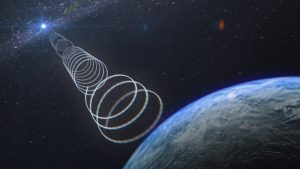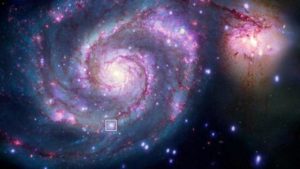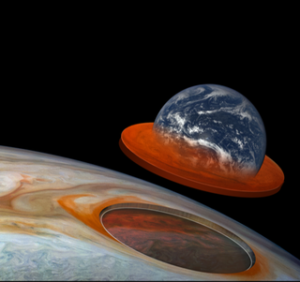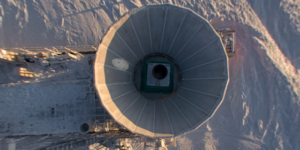Last month had some unusual celestial radio waves, some unusual exoplanets, some cool planetary exploration and some bashing of trendy theories. You read that right.
🌒
Bunches of strange radio waves are coming from the center of the Milky Way, looking unlike any known before.

The australian radiotelescope ASKAP saw them six times over nine months in the past year. Each time they seemed to switch on out of the blue, get brighter -some times as much as a hundred times- and then fade away. When they reappeared, it seemed to happen at random times. Also, they were very polarized (which doesn’t mean fighting on facebook, but when the light waves oscillate in only one direction).
There is a number of usual suspects for weird radio waves, but none fits the bill. More specifically, the observed signals can’t be pulsars, flaring stars, supernovae, or fast radio bursts. But, if this has anything to say, it seems that astronomers have started grouping some other similar kinds of observations together, under the name “galactic center radio transients”. Promising.
🌓
In the wtf news of the month, astronomers found for the first time a planet in another galaxy.

The planet was spotted by the Chandra telescope, through changes in the X-rays reaching us from the binary star M51-ULS-1. This is in the photogenic galaxy M51, commonly known as the Whirlpool. The changes can’t be explained by gas or dust shading the star (in that case the light would also change colours), but they could be coming from a small body transiting periodically in front of the star. So, say hi to the newly discovered planet 28 million light years away.
🌕
We now know how deep the Great Red Spot on Jupiter goes. And we know this in spectacular ways.

Juno, the Jupiter explorer by NASA, found that the iconic storm extends to about 500 kilometers below the cloud tops (which makes it rather shallow, as its diameter is 16,000 kilometers).
Juno scanned Jupiter’s clouds with a microwave radiometer as it passed over it a few dozen times in 2016. The results of the analysis were now published along with a convoy of many other studies.
But in addition, the scanning measurements were cross-checked in an impressive way: by measuring the gravity attraction on Juno, which was done by tracking its motion from 650 million kilometers away. This means from Earth.
NASA’s Deep Space Network, an array of radio telescopes for the support of space missions, was tracking Juno’s speed and it could detect changes as small as a hundredth of a millimeter per second. In this way it was possible to calculate the gravity pull on it by Jupiter, and how it changed when the spacecraft flew over different areas – and so, indirectly, how much mass lies in each area below the clouds. (Now, I try to add some smartass joke here, but honestly I am too awed by the awesomeness of this.)
🌗
The next one is big in terms of epistemology and I love it, but be warned. If you are not interested in hearing how bad the situation with modern physics is, then it’s better to stop reading here.
The news: The telescope BICEP2 has not found any evidence of gravitational waves from shortly after the big bang.
How is this news? In two ways.

First, a lot of the time work in particle physics or in cosmology (which is the case here) consists of not finding any of specific predicted things. This way a theory can be eaten away little by little – by excluding more and more of the possible values that its parameters can have, until no room is left. So, many of the results consist of looking for more and more things predicted by a theory and not finding them. (These are still important results just not so catchy. I blame it on influencers who encourage our short attention span.)
Second, it takes some piss out of the theory of inflation and of BICEP2 itself.
Let me try to make more sense. The theory of inflation is a popular model in cosmology; it mainly says that at its beginning the universe expanded at such an incredible rate that it resulted in innumerable “bubble universes” which cannot communicate with each other; we are supposed to be in one of them.
As with all physics theories, this one was also based on some existing hints and it tries to solve some open questions (surrounding observations of the universe). However, it’s obviously a theory that makes very bold statements about, literally, life, the universe and everything. Many physicists feel that, accordingly, it should have a lot more proof to show than it currently has. To make things worse, the inflationary model can be manipulated in terms of math so much that it can be made to fit any cosmological observation retroactively. Unfortunately, this hasn’t stopped it from being proclaimed correct by many cosmologists, even without enough supporting evidence. (You can read more on this debate by someone who says it better than me.)
Now you might see why above I said something about “the situation with physics”. Wait, the drama has only started.
One of the main predictions of inflation is that there is a telltale signal in the skies: the imprint of “primordial” gravitational waves, caused by fluctuations in the very young universe, in the light that has survived from that era. Finding this would certainly be good supporting evidence for inflation.
Enter BICEP2. This is a bespoke experiment for catching said gravitational waves. And in 2014 it announced that it did.
A few wild months of partying followed for inflation aficionados. (Hell, even I drank a few glasses to its success, and you can easily guess whether I am an inflation aficionado.)
Then, the mistake in BICEP2 people’s calculations was found and the house of cards collapsed. (For the record, their “telltale” observations actually came from dust in the Milky Way.)
You expect a moral in this story? There is none. Inflation aficionados are as fanatic as ever, and most researchers from BICEP2 are rumored to have found good jobs before the truth surfaced. BICEP2’s director, instead of apologizing to someone, even wrote a book claiming that he lost a nobel prize (no, I haven’t understood this either).
Perhaps I don’t need to write more to make you see why last month’s announcement, ie. the lack of BICEP2 results confirming inflation, feels so sweet to some…
But I can sign off by clarifying something: inflation has not been disproved yet; there are still possible values that its parameters can have. Only that they are far away from those expected for the most popular inflationary models, which was kind of a blow.
But I wouldn’t worry about the aficionados. The theory of inflation can always be manipulated in a way that fits observations retroactively. If you want to believe in multiple universes, why let facts stand in the way.
—
Do you want to receive one monthly reminder with links to the Ph-word posts? Join the mailing list.
